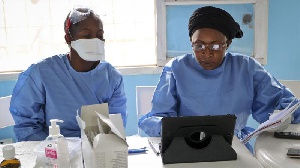Statement: The conspiracies behind malaria eradication in Africa must stop!
Malaria continues to threaten the lives of people despite huge funds made available to fight this preventable disease. According to the 2010 report “Breaking the Cycle: Saving Lives and Protecting the Future” by the Department for International Development (DFID), global funding for malaria has increased from $0.733 billion in 2006 to $1.94 billion in 2009. Despite the increasing funds for malaria control, the disease still kills about 800,000 people each year with the Africa [Sub-Saharan region] being the hardest hit [90 percent].
The 2010 World Malaria Report asserts that the number of deaths due to malaria is estimated to have decreased from 985,000 in 2000 to 781,000 in 2009. The largest absolute decreases in deaths were observed in Africa. There is no doubt that deaths caused by malaria especially in sub-Saharan Africa can be likened to fierce devastations of natural disasters like Haiti earthquake and the tsunami in Japan. When one in five child deaths are malaria related in Africa, one should wonder if the celebration of the World Malaria Day on April 25 is not meaningless. The reality is that Africans are made to remember the accursed disease ripping precious lives apart with no end in sight.
While progress in reducing malaria burden has been remarkable, the hypocrisy of funding agencies and bodies is glaring. Osagyefo Network for Rural Development (OSNERD), a non-governmental organization based in Ghana, has the stark believe that the world outpouring of support towards malaria control and eradication in Africa is clandestinely fraught with lethal conspiracies. These conspiracies have one focus - to perpetrate the threats of malaria to the dire consequence of the Africa region especially sub-Saharan Africa to the interest of “hidden hands”.
With the global orchestrated goal of eradicating malaria in Africa using insecticide-treated mosquito nets (ITNs) and artemisinin-based combination therapies (ACTs), the hope of eradication is definitely far from Africa’s reach. In the 2010 World Malaria Report, it is stated that approximately 289 million ITNs will have been delivered to sub-Saharan Africa, enough to cover 76% of the 765 million persons at risk of malaria by the end of 2010. Why then do we have as large as 90 percent of the people in the same region [Africa] being killed as at 2009?
OSNERD does not disregard the significance of ITNs and ACTs but bemoans the hands that want Africa to grapple with malaria till the end of the world. ITNs and ACTs are the not the sustainable antidote to counter malaria. In the first place, though ITNs and ACTs have contributed to global reduction of malaria cases and deaths, current death rates are considerable. Did global organizations and agencies ever propose the use of ITNs and ACTs when malaria hijacked the progress of the United States and other developed countries in the 1950s? The use of ITNs in Africa has serious challenges. The hot tropical weather always convinces the ordinary people to disregard these ITNs. Now, how many hours of sleep do the pregnant woman and the child under five have in the treated nets? From the time 18:00 to 21:00 before going to bed, are children and pregnant women insulated from mosquito bites?
It is stated in the 2010 World Malaria Report that “information from manufacturers indicates that the number of ACTs procured has increased in every year since 2005”. This is exactly the issue. Without malaria, how will these manufacturers of, artemisinin-based combination therapies (ACTs) and bednets sustain their huge economic interests? In hindsight the corporate world benefits from increased malaria cases in Africa. It is worrying that the ineffable sadness of malaria in Africa rather brings enormous benefits to anti-malarial drug and bed-net manufacturers and some funding organizations.
Thirty-nine African countries have united against the disease under African Leaders Malaria Alliance (ALMA), chaired by Tanzanian President Jakaya Kikwete. Definitely, this group has joined the global voice that believes in excessive distribution of ITNs when Africans are needlessly dying. They have started on the wrong premise. OSNERD will entreat African head of states under ALMA to change focus or keep up with the formalities of malaria eradication while their economies deteriorate and its people are outrageously annihilated.
OSNERD believes the strategy of aerial application of insecticides that decimate malaria parasite is the most efficient and economical. Regardless of the bad reputation attached to the strategy insecticides like DDT, this strategy has been tested and known to be the most cost-effective approach in eradicating malaria that has bedridden already worst African economies. In Tanzania, up to 39% of the total health expenditure – equivalent to 3.4% of the nation’s GDP – is direct to malaria prevention and care. In Ghana, according to study conducted by the Ministry of Health in 2008, estimated annual economic cost of reported malaria cases alone in Ghana is US$772.4 million where the figure is hovering around GH¢30.04 or US$32.65 per person. It is again stated in the DFID report that malaria in sub-Saharan Africa results in an average reduction in annual growth of 0.55% and as much as 1.3% in the highest burden countries. This is the most critical that should call for a sharp and efficient malaria eradication method.
The system of aerial application that has been developed over the past 11 years is the only one that meets the science and has a theoretical increase in efficiency of 2000 to 1 over the systems in use today in the US. For years the populated areas of Palm Beach County in Florida have been treated in only 3 hours and 20 minutes saving the County $200,000 dollars in insecticide use and malaria eradication. Indeed, there is a miracle when it comes to effective malaria control. Aerial application is efficient and cheaper than indoor residual spraying.
The United Nations, World Bank, Global Fund, ALMA, W.H.O and most malaria foundations are all guilty of the mass suffering of the African people. They should not be oblivious of the fact that economies in Africa cannot achieve the Millennium Development Goals by 2015 if intensity of threats of malaria goes on like this. Millions of dollars are being lost, hundreds of thousands of innocent people are perishing while the mental and physical developments in children are being affected. Better education is then at risk. This is what malaria presents to Africa. When the World Bank’s pledge of US$200 million to anti-malaria efforts in Africa in 2009 went largely to provide bed-nets to families in the Democratic Republic of Congo, Ethiopia, Ghana, Kenya, Mozambique, Sierra Leone and Zambia, there is a serious cause for concern. Poor and rural households often benefit less from malaria programmes and have lower access to public health services. How many poor and rural people even have access to ACTs and even ITNs?
OSNERD admonishes these so-called ‘people-centered’ organizations and agencies to set their priorities right. Insecticide-treated mosquito nets and anti-malarial drugs are very useful but cannot best lead the cause of malaria eradication in sub-Saharan Africa. Application of insecticides [aerial approach and IRS] along with the “globally sacred” strategy [ITNs and ACTs] is exactly what will bring salvation to lives at risk. OSNERD is therefore calling on W.H.O to invalidate the 1997 World Health Assembly resolution 50.13, which calls on countries to reduce reliance on the use of insecticides for disease control. A new resolution building on the importance of insecticides like DDT in disease control especially malaria is significant.
OSNERD also demands an end to the misguided and baseless campaign run by the United Nations Environment Programme (UNEP) to eliminate DDT in malaria vector control by 2020.
OSNERD is challenging the W.H.O, UN, World Bank, Global Fund, DFID and other funding organizations to increase new public and private investment in public health insecticides towards malaria vector control. Research into the use of biological insecticide formulations like DDT has the potential of providing a cheap and environmentally safe method for dealing with malaria. The Global Fund, W.H.O, World Bank and the UN and its agencies should support advocacy campaigns on the need for new public health insecticides while reducing the barriers in their usage.
One of the prominent critics of W.H.O, Professor Nicholas White, director of the Welcome Trust’s South-East Asia Overseas Unit and one of the world’s leading researchers on malaria drug resistance once said “it is terrible to waste lives and money deploying a useless drug”. There is no doubt W.H.O, the Global Fund and other agencies are aware of the exact solution to this plight of Africans. Malaria eradication strategies in Africa need a total overhaul. OSNERD wants to ask do the UN, World Bank, Global Fund, ALMA, W.H.O and other funding organizations think of eradicating malaria in Africa or make business out of it. Are they behind these conspiracies? Is W.H.O not failing the rest of Africa?
As UN Secretary General, during this year’s World Malaria Day, underscored the need to scale up lifesaving and cost-effective interventions, OSNERD charges the UN, W.H.O and the Global Fund to adopt the right interventions that will ramp up efforts toward ending the malaria scourge especially when foreign aid and supports suffer from cutbacks around the world.
Malaria has created a dangerous reality of “poverty in grand style” in Africa that provides grounds for rethinking. These hypocrisies and conspiracies of world agencies must end now!
The author, Stephen Yeboah, is the National Coordinator for Osagyefo Network for Rural Development (OSNERD), a rural-based non-governmental organization in Ghana. He can be reached at [stephenyeboah110@yahoo.com]
Opinions of Tuesday, 3 May 2011
Columnist: Yeboah, Stephen














